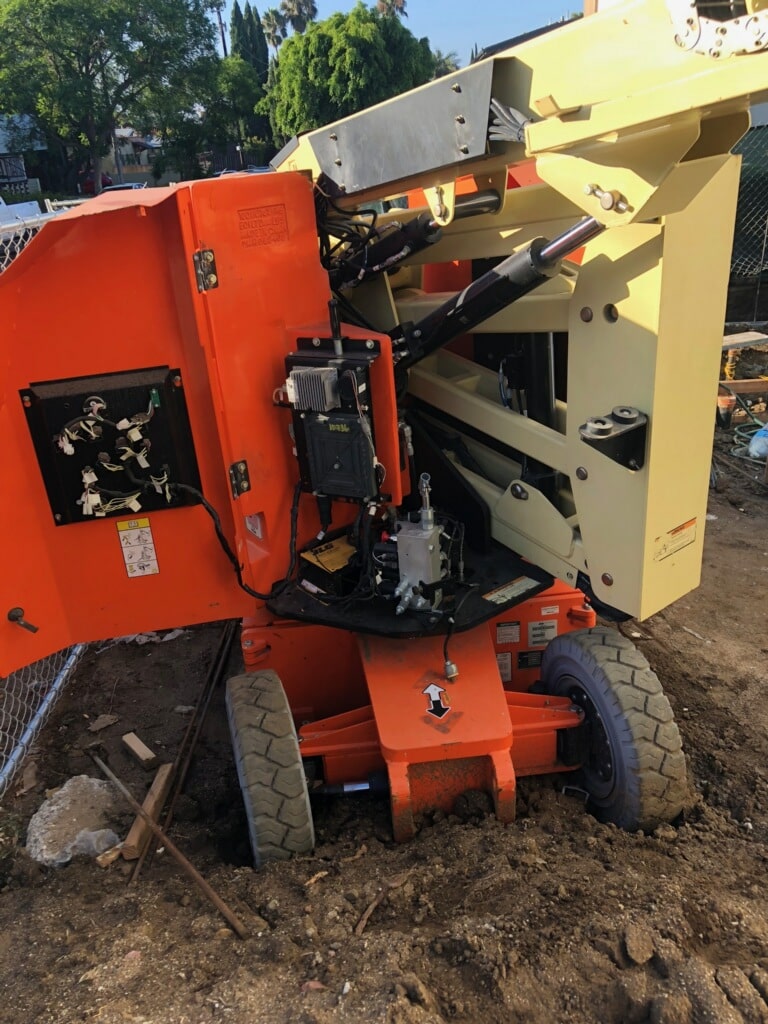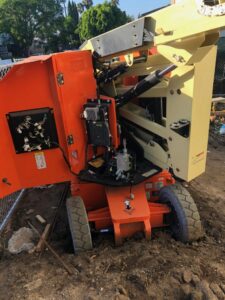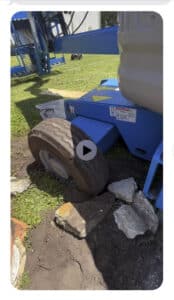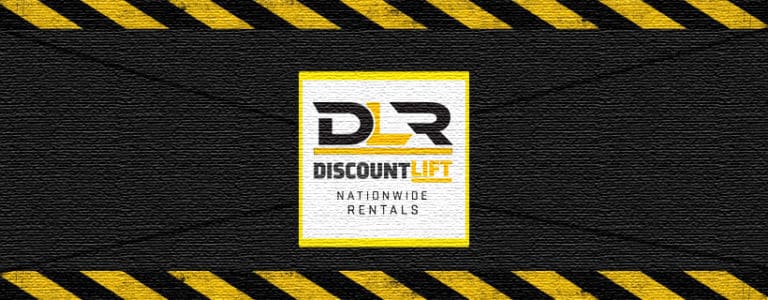
The Math of Getting Stuck – To 4WD or Not to 4WD
Published : October 5, 2023Should you pay the extra cost to rent a 4WD fueled machine?
Renting a scissor or boom lift with 4×4 will cost you more money but as a couple of Discount Lift Rentals customers recently found out. Getting a machine unstuck will cost a lot more. If you are going to be driving on grass, gravel, dirt, sand, mud, snow or anything not concrete or asphalt, you need to rent fueled four wheel drive scissor lift and or boom lift. When working on a concrete or asphalt jobsite you can save money and rent an electric scissor lift or electric boom lift. Most fueled scissors and booms are 4×4 or four-wheel drive and all electric scissor lifts and electric boom lifts are 4×2.

JLG 30′ Boom Lift Rental stuck in the mud

Genie 45′ boom stuck in the mud
Can you get a 4×4 stuck?
This brings up some good questions. I am sure there are a lot of 4×4 clubs and Jeep clubs that could answer this better than I can. First, I looked at Google and I guess I am the only one to ask how to get your truck stuck. It seems people only want to know how to get their trucks unstuck. If you do get your car, Jeep or truck stuck Google has a lot of videos and articles for you to go find. I continued my research with Chat GPT and I really like it’s answer. I italicized Chat GPT answers. It also had some good tips of all construction equipment rentals. Please remember I asked about a car or truck not an electric scissor lift.
Determining whether your car, truck or Jeep will get stuck in dirt, mud, sand, or any other material depends on various factors, including the type of terrain, the condition of your vehicle, and your driving skills. Here are some considerations to help you assess the risk of getting stuck:
-
Terrain Type:
Soft materials like deep mud, loose sand, or deep snow are more likely to trap a vehicle compared to hard-packed dirt or gravel. Wet or saturated ground can make it easier to get stuck, as it reduces traction.
Before renting construction equipment, you should look at the jobsite for conditions and obstacles not only on the ground but in the air too. Hitting a power line will upset your day more than getting stuck. It might kill you. Always check your work area before each time using the equipment too.
-
Vehicle Type:
The type of vehicle you’re driving matters. Four-wheel drive (4WD) and all-wheel drive (AWD) vehicles generally have better off-road capabilities than two-wheel drive (2WD) vehicles.
Larger and heavier vehicles with higher ground clearance are often better at navigating challenging terrain.
My 2019 Jeep weighs 4439 lbs and my Ram 1500 truck weighs around 5000 lbs. The Ram has a wheel base of 153.5” and a body width of 82.1”. The Jeep has a wheelbase of 118.4” and a body width of 73.8”. Both of them have air filled mud tires and a ground clearance of over 10”. And yet I still have a winch on the front of the Jeep in case I get stuck. Now let us compare these to the two boom lifts they got stuck.
Here is a quick comparison.
JLG E300 – Electric Boom Lift JEEP Wrangler
Ground Clearance 4 in 10 in.
Wheelbase 5 ft 5 in 9 ft 10 in.
Machine Width 4 ft 6 ft 2 in.
Weight 15,705 lbs. 4,439 lbs.
Genie Z45 – Electric Boom Lift Ram 1500
Ground Clearance 9.5 in 10 in.
Wheelbase 6 ft 8 in 12 ft 9.5 in.
Machine Width 5 ft 10 in 6 ft 10 in.
Weight 16,315 lbs. 5,024 lbs.
As you can see the boom weight is about three times the weight of the truck or Jeep. Then you add the smaller foot print and the ground bearing pressure is greatly increased.
-
Tire Type:
The condition and type of tires can significantly affect your ability to traverse different surfaces. Off-road or all-terrain tires provide better traction on uneven terrain compared to standard road tires.
If you look at the tires in the pictures, the machine tires have worse tread than even a standard car tire. They aren’t going to grip the dirt very well.
Tire Size
JLG E300AJ – 7 x 12 Non-marking Solid Tires
Genie Z45/25 9 x 14.5 Solid Tires
Jeep BF GoodRich LT285/70R17
Ram 1500 Nitro 33×12.5R 18LT
-
Tire Pressure:
Adjusting tire pressure can make a significant difference. Lowering tire pressure increases the contact area and can improve traction on soft surfaces like sand. However, it may reduce fuel efficiency on the road, so be sure to reinflate the tires afterward.
Electric scissor lift and electric boom lifts have solid tires and the air pressure cannot be adjusted to the terrain.
-
Ground Clearance:
Vehicles with higher ground clearance can clear obstacles and avoid getting stuck more easily than those with lower clearance.
A 19 ft scissor has a ground clearance of 3 in when the machine is all the way down. Once you go up in the air the pothole protection bars are lowered into place and the ground clearance is reduced to less than an inch. Even the JLG E300AJ the customer got stuck only has 4 inch ground clearance. The Genie Z45/25 with the 9 inch clearance didn’t seem to help it not get stuck.
-
Driving Technique:
Your driving skills plays a crucial role. Maintaining momentum and avoiding sudden stops or sharp turns can help prevent getting stuck.
Use a low gear and avoid spinning the wheels excessively.
On a boom lift or scissor lift you are driving with a joystick. Most of them these days have proportional controls but it is still difficult to not let the tires slip on a slick surface.
-
Recovery Gear:
Carrying recovery gear such as traction mats, tow straps, a shovel, and a winch can be invaluable in getting your vehicle unstuck if it happens.
If you are out playing with your 4×4 Jeep then these are good suggestions. If you are using a boom lift make sure you don’t get stuck.
-
Assess the Situation:
Before attempting to drive through uncertain terrain, visually inspect it to gauge the difficulty. Look for ruts, soft spots, and obstacles. If you’re unsure about the conditions, consider walking the path first or seeking advice from locals or experienced off-roaders.
You should always walk around and jobsite and inspect it each day before operating your equipment. On a construction site, things may change from day to day. I have seen where someone will lay plywood over holes to stop people from walking into the hole. However, this will not stop a machine from falling in the hole. The tire’s weight will punch a hole right through the plywood.
-
Know Your Limits:
It’s essential to know your vehicle’s capabilities and your own driving skills. Avoid taking unnecessary risks, and be prepared to turn back if the terrain becomes too challenging.
Know the construction equipment’s limits and never use them for something other than their intended purpose.
-
Plan Ahead:
If you anticipate driving in challenging conditions, let someone know your route and expected return time. Carry essential supplies like water, food, and communication devices in case you get stuck or stranded.
Remember that even with careful planning and preparation, there’s always a risk of getting stuck in challenging terrain. When in doubt, it’s often safer to avoid such conditions.
After I was done researching getting stuck in the mud.
I wanted to see the math behind getting stuck in the mud. I found Engineering Tool Box website that had some good formulas.
The math behind it.
This information was borrowed from Engineeringtoolbox.com. ( I hope they don’t mind )
https://www.engineeringtoolbox.com/tractive-effort-d_1783.html
The tractive force between a car wheel and the surface can be expressed as
F = μt W
= μt m ag (1)
where
F = traction effort or force acting on the wheel from the surface (N, lbf)
μt = traction – or friction – coefficient between the wheel and the surface
W = weight or vertical force between wheel and surface (N, lbf))
m = mass on the wheel (kg, slugs)
ag = acceleration of gravity (9.81 m/s2, 32.17405 ft/s2)
Traction Coefficients for normal Car Tires
| Surface | Traction Coefficient – μt – |
| Wet Ice | 0.1 |
| Dry Ice/Snow | 0.2 |
| Loose Sand | 0.3 – 0.4 |
| Dry Clay | 0.5 – 0.6 |
| Wet rolled Gravel | 0.3 – 0.5 |
| Dry rolled Gravel | 0.6 – 0.7 |
| Wet Asphalt | 0.6 |
| Wet Concrete | 0.6 |
| Dry Asphalt | 0.9 |
| Dry Concrete | 0.9 |
So, unless you are looking to rent a lift as a science experiment on the traction coefficient or helping your kids on their STEM project, it is a good idea to make sure you have the right machine for your jobsite.
To 4×4 or not to 4×4, that is the question. Whether ’tis nobler on the pavement or to suffer the bumps and potholes of outrageous terrain and, by opposing, drive them? To tread, to grip—no more—and by a grip to say we end the slip and the thousand natural shocks that tires are heir to. ‘Tis a consummation devoutly to be wheeled.
Please call a DLR customer service representative today and rent all of your construction equipment today.
